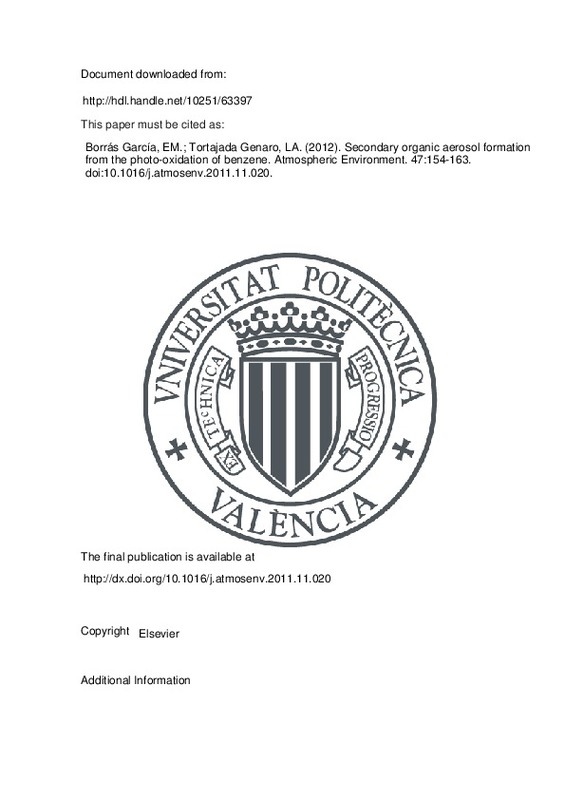Borrás García, EM.; Tortajada Genaro, LA. (2012). Secondary organic aerosol formation from the photo-oxidation of benzene. Atmospheric Environment. 47:154-163. https://doi.org/10.1016/j.atmosenv.2011.11.020
Por favor, use este identificador para citar o enlazar este ítem: http://hdl.handle.net/10251/63397
|
Título:
|
Secondary organic aerosol formation from the photo-oxidation of benzene
|
|
Autor:
|
Borrás García, Esther Mª

 Tortajada Genaro, Luis Antonio
Tortajada Genaro, Luis Antonio
|
|
Entidad UPV:
|
Universitat Politècnica de València. Instituto de Reconocimiento Molecular y Desarrollo Tecnológico - Institut de Reconeixement Molecular i Desenvolupament Tecnològic
Universitat Politècnica de València. Departamento de Química - Departament de Química
|
|
Fecha difusión:
|
|
|
Resumen:
|
The production of condensate compounds from the degradation of benzene by OH radical chemistry was studied. Secondary organic aerosol (SOA) formation was investigated in the EUPHORE (European Photoreactor) simulation ...[+]
The production of condensate compounds from the degradation of benzene by OH radical chemistry was studied. Secondary organic aerosol (SOA) formation was investigated in the EUPHORE (European Photoreactor) simulation chambers. Experiments were performed under different OH-production conditions - addition of H 2O 2, NO or HONO -, in a high-volume reactor, with natural light and in the absence of seed aerosols. The consumption of precursor/reagents, the formation of gas-phase and particulate-phase products and the temporal evolution of aerosol were monitored. Several aerosol physical properties - mass concentration, overall aerosol yield, particle size distribution and density - were determined and found to be clearly dependent on OH radical production and NO x concentrations. Furthermore, the use of one and/or two products gas-particle partitioning absorption models allowed us to determine the aerosol yield curves. The SOA yield ranged from 1.6 to 9.7 %, with higher SOA formation under low-NO x conditions. Chemical characterization of the SOA was carried out, determining multi-oxygenated condensed organic compounds by a method based on the gas chromatography-mass spectrometry technique. Several ring-retaining and ring-cleavage products were identified and quantified. The compounds with the highest percentage contribution to the total aerosol mass were 4-nitrobenzene-1,2-diol, butenedioic acid, succinic acid and trans-trans-muconic. In addition, a multigenerational study was performed comparing with the photo-oxidations of phenol and catechol. The results showed that although the mass concentration of SOA produced was different, the physical and chemical properties were quite similar. Finally, we suggest a general mechanism to describe how changes in benzene degradation pathways - rate of OH generation and concentration of NO x - could justify the variation in SOA production and properties. © 2011 Elsevier Ltd.
[-]
|
|
Palabras clave:
|
Benzene
,
Catechol
,
Multi-oxygenated compounds
,
Phenol
,
SOA yield
,
Absorption model
,
Aerosol mass
,
Benzene degradation
,
Chemical characterization
,
Gas chromatography-mass spectrometry techniques
,
Gas-particle partitioning
,
Gasphase
,
Mass concentration
,
Natural light
,
OH radical
,
Photoreactors
,
Physical and chemical properties
,
Secondary organic aerosols
,
Simulation chambers
,
Succinic acids
,
Temporal evolution
,
Two-product
,
Yield curve
,
Biodegradation
,
Chemical compounds
,
Chemical properties
,
Degradation
,
Free radicals
,
Gas chromatography
,
Mass spectrometry
,
Particle size
,
Particle size analysis
,
Phenols
,
Size distribution
,
Atmospheric aerosols
,
4 nitrobenzene 1,2 diol
,
Butenedioic acid
,
Catechol derivative
,
Hydroxyl radical
,
Muconic acid
,
Phenol derivative
,
Succinic acid
,
Unclassified drug
,
Absorption
,
Aerosol
,
Concentration (composition)
,
Condensate
,
Gas phase reaction
,
Photooxidation
,
Article
,
Gas
,
Light
,
Particulate matter
,
Physical phase
,
Priority journal
,
Reactor
,
Smog
|
|
Derechos de uso:
|
Reserva de todos los derechos
|
|
Fuente:
|
Atmospheric Environment. (issn:
1352-2310
)
|
|
DOI:
|
10.1016/j.atmosenv.2011.11.020
|
|
Editorial:
|
Elsevier
|
|
Versión del editor:
|
http://dx.doi.org/10.1016/j.atmosenv.2011.11.020
|
|
Código del Proyecto:
|
info:eu-repo/grantAgreement/MICYT//REN2002-01484/
info:eu-repo/grantAgreement/MEC//CSD2007-00067/ES/MULTIDISCIPLINARY RESEARCH CONSORTIUM ON GRADUAL AND ABRUPT CLIMATE CHANGES, AND THEIR IMPACTS ON THE ENVIRONMENT (GRACCIE)/
|
|
Agradecimientos:
|
The authors wish to thank J.T.B, Martin-Reviejo, the Spanish Ministry of Science and Technology IMSEUR project (Project no REN2002-01484/CLI). The Instituto Universitario CEAM-UMH is partly supported by Generalitat Valenciana, ...[+]
The authors wish to thank J.T.B, Martin-Reviejo, the Spanish Ministry of Science and Technology IMSEUR project (Project no REN2002-01484/CLI). The Instituto Universitario CEAM-UMH is partly supported by Generalitat Valenciana, Fundacion Bancaja, and the projects GRACCIE (Consolider-Ingenio 2010) and FEEDBACKS (Prometeo-GVA).
[-]
|
|
Tipo:
|
Artículo
|







![[Cerrado]](/themes/UPV/images/candado.png)




